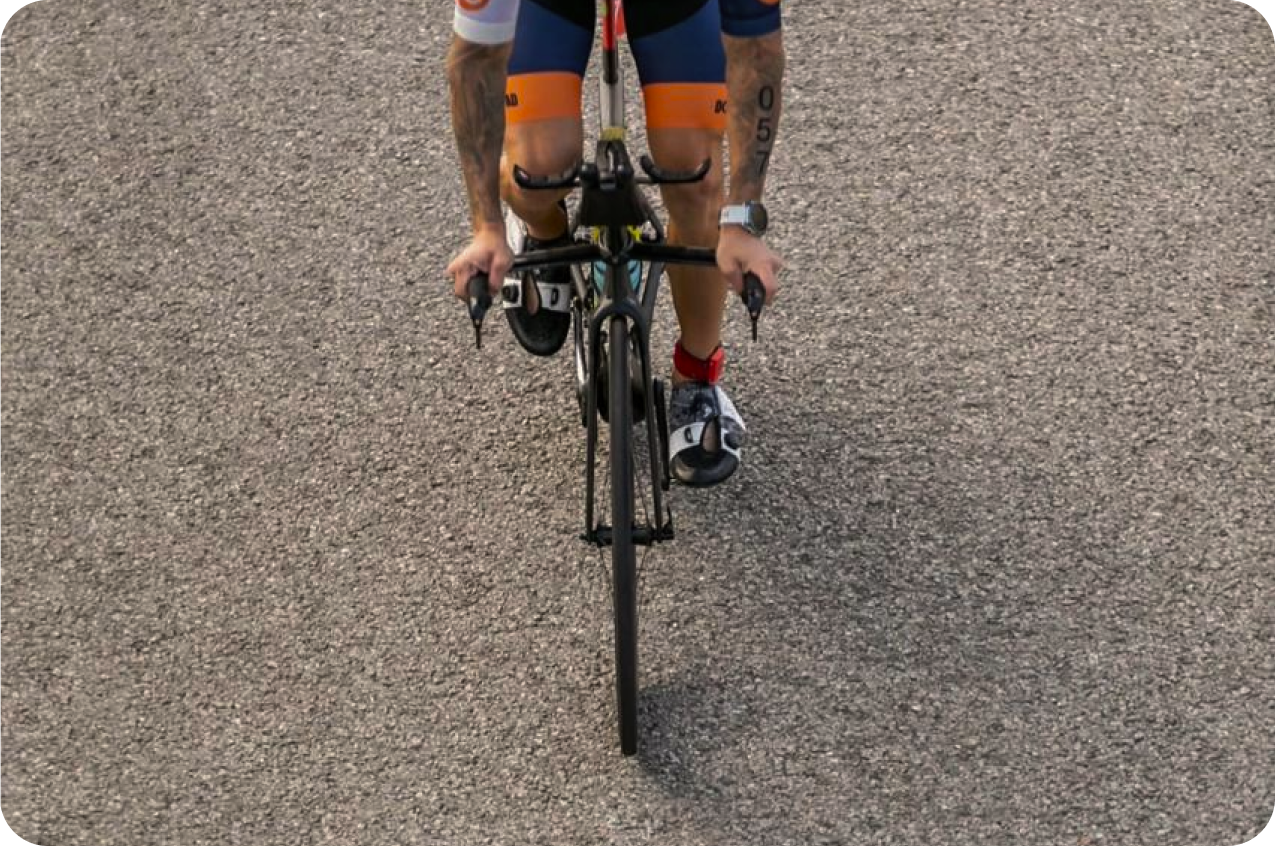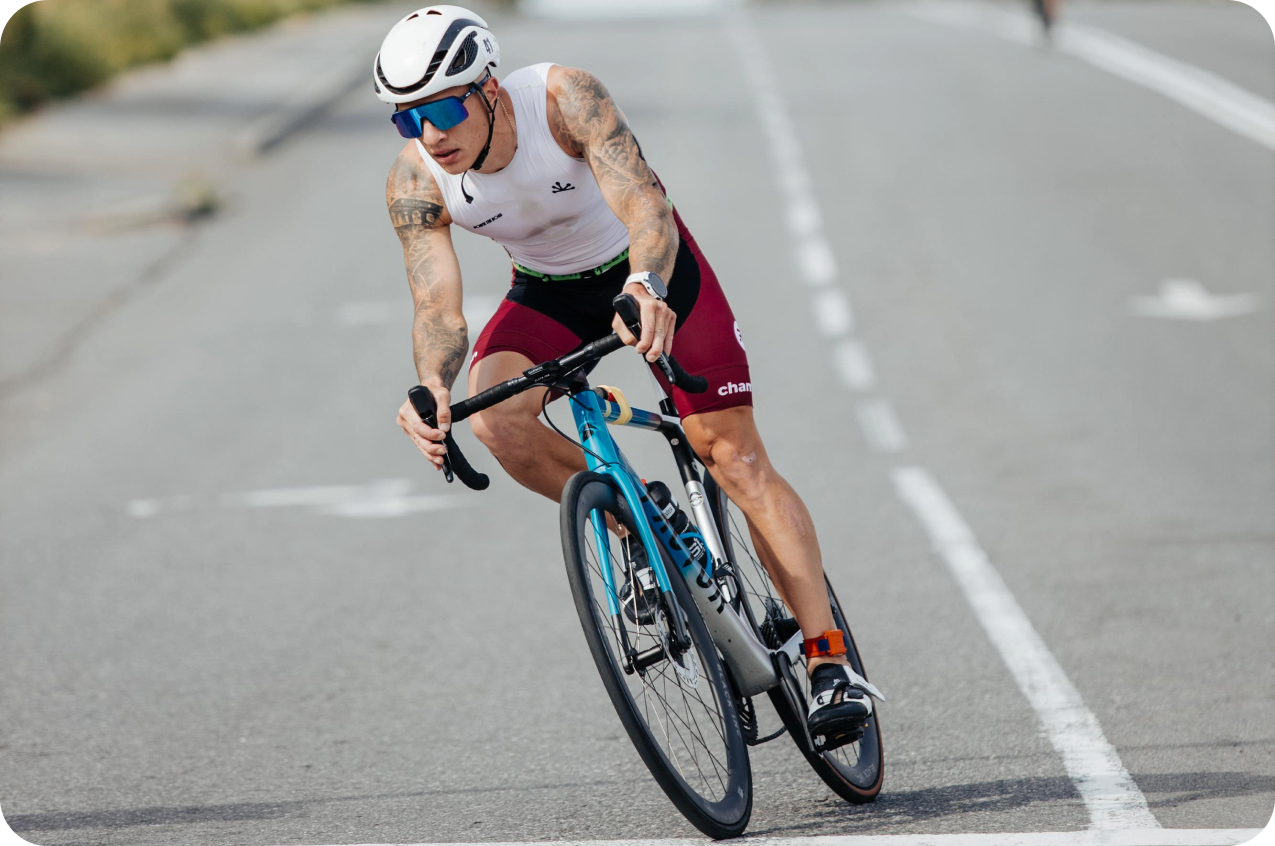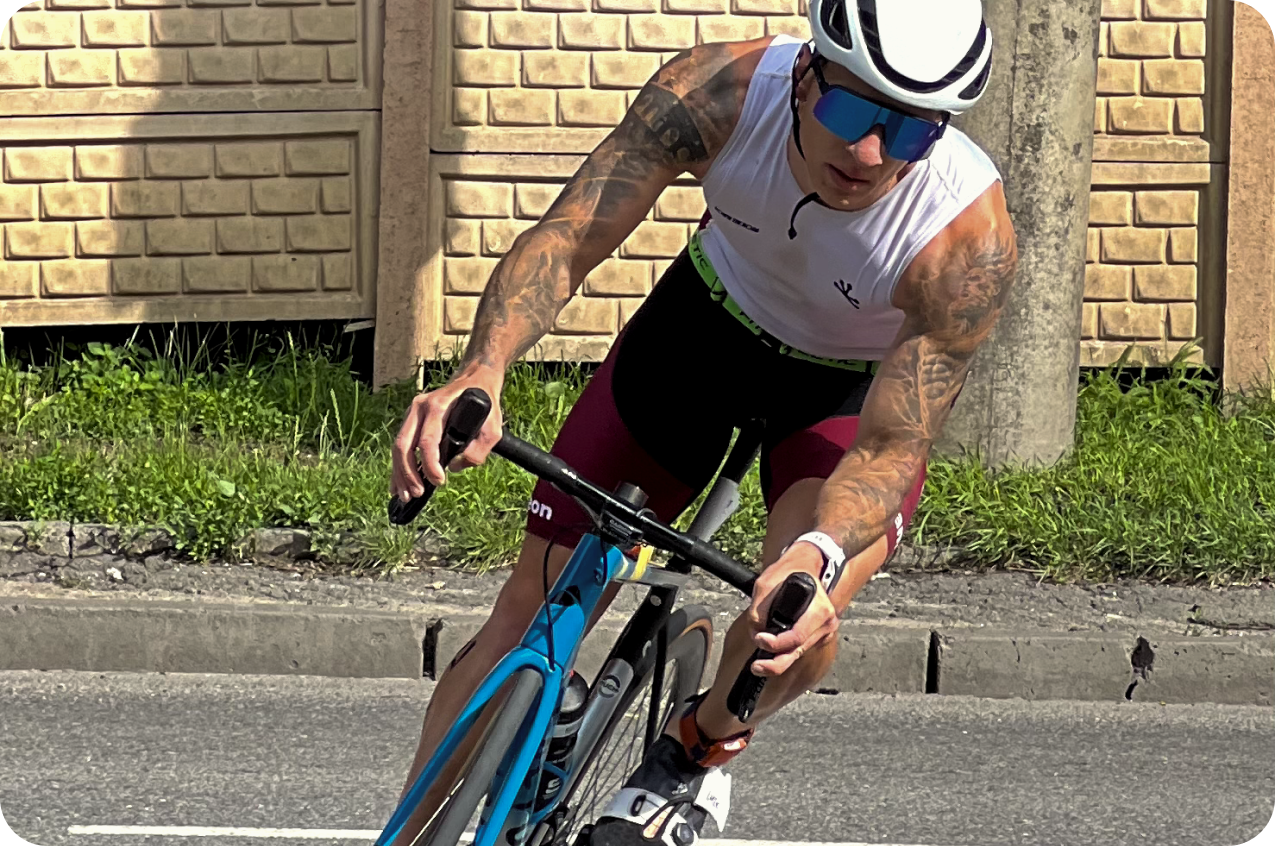Interval training is a must-have for everyone who wants to get better at cycling.
No matter if you’re just starting out or already advanced.
Interval training is often called HIIT, and it’s all about mixing short bursts of hard effort with rest.
The reason it’s so effective is that it helps build two important things: your ability to use oxygen efficiently (aerobic fitness) and your ability to push hard without needing oxygen for short periods (anaerobic fitness).
Both of these are key to getting better and faster on the bike.
Even though most of your rides should be easy and steady (around 70-80% of your training), those hard interval sessions (20-30% of your time) are what really help you improve.
When you mix them into your training routine, you’ll see some serious gains in your speed and overall performance.
Let’s explore this topic further.
What is Cycling Interval Training?
Cycling interval training is a type of workout where you switch between high-intensity bursts and recovery periods.
This means you pedal really hard for a short time (like 1-2 minutes), then slow down to recover for a few minutes before repeating.
Interval workout is great for building endurance, strength, and speed.
You can start with a few intervals and gradually increase as you get stronger.
It keeps things fun and challenging!
Benefits of Interval Training for Cyclists
Interval training has a lot of benefits for cyclists, especially if you’re training for triathlon races.
A study published in the Journal of Applied Physiology found that high-intensity interval training (HIIT) significantly improves VO2 max, which is crucial for endurance performance.
The research showed that short bursts of intense exercise followed by recovery periods are effective for increasing aerobic capacity.
Let’s explore this further.
First, high intensity interval training improves your cycling speed. When you push yourself during the high-intensity parts, your body adapts to working harder.
It helps you ride faster over time.
Second, alternating training zones builds your endurance.
The recovery periods allow you to go longer, helping build your overall stamina for longer rides.
Cycling at high intensity works your muscles harder, especially your legs and core, making them stronger and more efficient.
Learn more about muscles worked when biking in our recent article
Additionally, your heart and lungs get a great workout during intervals, improving your overall aerobic capacity.
Because you’re alternating between hard efforts and rest, it keeps your metabolism revved up, even after the workout is done.
Plus, interval training is time-efficient.
You can get a great workout in less time compared to steady rides. It keeps things interesting, so you’re less likely to get bored.

Types of Cycling Intervals
Yes, there are different types of cycling intervals, each designed to target specific areas of fitness.
Here are a few common ones:
Super High Intensity Intervals
Super High-Intensity Intervals (often called sprint intervals or SHIIT) are short bursts of all-out effort.
They last 15-60 seconds, followed by plenty of rest, usually about four times as long as the sprint.
The rest is important so you can fully recover before the next sprint.
While these intervals don’t always get the attention they deserve, they offer big benefits.
Super high-intensity intervals help increase your VO2 max (how much oxygen your body can use), boost your FTP (the power you can hold over a long effort), and improve neuromuscular power (your ability to generate quick bursts of speed).
They’re especially useful for older athletes who might feel like they’ve lost some of their natural speed.
Threshold Intervals
These intervals are longer, around 5-20 minutes at a hard but sustainable pace (close to your “lactate threshold”).
Recovery between intervals is usually shorter, around 2-5 minutes. These help boost your endurance and improve your ability to maintain a steady, high pace.
That’s the same principle behind the Norwegian training method, where athletes use frequent, precisely controlled threshold sessions to build massive endurance without overtraining.
High-Intensity Intervals
Also known as VO2 max intervals, high-intensity intervals last between 2-8 minutes.
These are ideal for improving your VO2 max, which is the maximum amount of oxygen your body can use in a minute.
Increasing your VO2 max is crucial for triathlon success, as it helps with endurance and overall performance.
High-intensity intervals are done at a slightly lower intensity because they last longer, but the rest periods are shorter, usually a 1:1 or 4:1 work-to-rest ratio.
These intervals are most effective when done during the main race season, as they prepare you for race day efforts.
Is it a good idea to train the day before a triathlon? Find out the answer in our recent blog.

Tempo Intervals
Tempo intervals are a bit different from typical HIIT workouts.
These intervals last from 10 to 60 minutes and are done at a moderately fast effort.
While they won’t boost your top speed or VO2 max like sprint intervals do, they are really important for race performance because they help you learn to maintain speed over longer periods.
As you get closer to race day, tempo intervals should become a key part of your training.
They help bridge the gap between speed and endurance, allowing you to hold a steady pace for longer.
Hill Repeats
As the name implies, you ride hard uphill for a set time or distance, then coast back down to recover.
Hill repeats build strength and power, especially in your legs, and are great for preparing for hilly courses.
Pyramid Intervals
These intervals gradually increase in interval duration and intensity (e.g., 1 minute hard, 1 minute easy, 2 minutes hard, 2 minutes easy, etc.), then come back down in the same pattern.
They’re good for mixing up your workout and pushing your endurance.
Generally, each type of interval has a different focus. So, feel free to mix them up based on what you want to improve.
Creating an Effective Interval Session
Alright, we’ve explored the benefits of intervals and their types. But how do you create an ultimate interval workout?
To make the most of your interval training, focus on two key things: how often you do them and the different types of intervals.
Triathlon coaches suggest that two interval sessions each week are ideal for improving performance.
You can occasionally add a third session, but if you do more than three, you risk burning out.
Remember, “more is not always better,” and doubling the number of sessions won’t necessarily double your results.
Now, let’s look at the example of an interval workout.
We will break it down into several stages and explain each one.
1. Warm-up
Start with 10-15 minutes of easy cycling to get your body ready. This prepares your muscles and heart for the harder effort ahead.
2. Choose your interval type
Decide on what you want to work on. For beginners, threshold or short intervals are a good starting point.
3. Set recovery periods.
Make sure to give yourself enough time to recover between intervals.
Recovery can be complete rest (very slow pedaling) or light effort, depending on how hard your intervals are.
4. Cool down
After your intervals, ride at an easy pace for 10-15 minutes to help your body recover and prevent stiffness.
You can gradually increase the intensity or number of intervals as you get stronger.
It’s all about finding a balance between pushing yourself and allowing your body to adapt.
Mental Preparation and Strength for Interval Training
Working out in a higher training zone can be tough.
It’s completely normal to feel a bit overwhelmed at first, but with a little preparation, both mentally and physically, interval sessions will feel more manageable over time.
Here’s how you can get ready:
Mental Preparation
- Don’t aim to crush it on day one. Start with a few intervals, and gradually build up as you get stronger. Know that it’s okay to feel uncomfortable — intervals are supposed to challenge you.
- Before you start, picture yourself completing the session. This positive reinforcement helps build confidence and reduce anxiety about the effort.
- Instead of thinking about the whole session, focus on completing one interval at a time. Celebrate small wins as you finish each one. It makes the workout feel less daunting.
- During the hard efforts, focus on your breathing, pedal stroke, or a spot on the road. This helps distract from fatigue and keeps you focused on form.
Physical Preparation
Make sure you’ve eaten a balanced meal or snack before your session. You’ll need energy to power through the tough efforts. Hydration is key, too.
Spend at least 10-15 minutes doing a gradual warm-up. Start easy and slowly build up intensity so your muscles are ready to handle the harder efforts.
Don’t go all-out on the first interval. Keep your energy in check so you can complete all the intervals without burning out too soon.
After your session, do a proper cool-down with easy pedaling and stretching. Also, prioritize recovery. Eat a post-workout snack and stay hydrated.
The more you practice, the easier it gets — both mentally and physically.
The key to mental preparation is to be patient with yourself and let your body adapt over time.

Common Mistakes to Avoid in Interval Training
Before you dive into the intervals to improve your cycling performance, there are a few common mistakes you need to be aware of.
Let’s check them out.
1. Going too hard, too soon
Many athletes push too hard in the first interval. This leaves them too exhausted to complete the session properly.
To avoid this, you want to start conservatively.
The goal is to maintain a consistent effort across all intervals.
2. Skipping recovery time
Athletes sometimes shorten their recovery periods, thinking that less rest means more gains.
But this can lead to burnout and decreased performance.
Stick to the planned training time and recovery time.
It’s during recovery that your body adapts and prepares for the next interval.
Without proper rest, you won’t be able to sustain high-quality efforts.
3. Doing intervals too frequently
Some athletes think more intervals mean faster progress.
But that doesn’t work like that. Too intense training plans lead to muscle fatigue and exhaustion.
You don’t want it to happen, so try to limit interval training to 1-2 sessions per week, especially as a beginner.
Your body needs time to recover and adapt between sessions.
Balance it with easier rides or endurance-focused sessions.
4. Not warming up or cooling down properly
Skipping or rushing through the warm-up or cool-down can increase the risk of injury or leave you feeling stiff after the workout.
Take 10-15 minutes to gradually warm up and cool down. Warming up preps your muscles, while cooling down helps with recovery and prevents muscle cramps while cycling.
5. Neglecting form and technique
When pushing hard, it’s easy to let your form slip. This can lead to inefficient pedaling or potential injury.
To make progress, you need to do your intervals properly without sacrificing form.
Focus on maintaining good posture and a smooth pedal stroke, even during high-intensity efforts.
This helps you get the most out of each interval.
6. Not listening to your body
Some athletes push through fatigue or discomfort, thinking they need to “tough it out.”
What you end up with is that your energy system is empty, and you are overtrained; your training stress score drops.
Pay attention to how your body feels.
If you’re extremely fatigued or feeling pain, it’s okay to skip a session or take extra rest.
Quality is more important than quantity when it comes to interval training.
How to Measure Progress and Adjust Your Training Plan
For low-intensity training, heart rate is a helpful way to gauge how hard you’re working.
But when it comes to interval training, it’s better to rely on how you feel (rate of perceived exertion) or your power on the bike.
That’s because heart rate can lag behind your actual effort by 1-2 minutes, which isn’t ideal for those quick bursts.
Using power is more accurate, but you’ll need a smart bike trainer with programs or a power meter on your bike.
If you don’t have one, don’t worry!
First, you’ll want to determine your Functional Threshold Power (FTP).
This is the maximum power (in watts) you can sustain for about an hour.
Here are a few ways to figure it out:
1. 60-Minute Test
Go all out for 60 minutes. Your average power during that time is your FTP. This test is pretty grueling and requires a lot of prep and experience.
2. 20-Minute Test
Push hard for 20 minutes. To find your FTP, take 95% of your average power during that ride. It’s still tough, but it’s a bit shorter than the hour-long test.
3. Ramp Test
In this test, you start at a low intensity and gradually increase the power every minute until you can’t go on.
Your FTP is 75% of your highest one-minute average power.
This option is great because it’s accurate and easier for newer athletes to perform.
Plus, you can do it every couple of months without messing up your training schedule.
Once you know your FTP, you can use it to set your cycling power zones, which will help you create effective interval sessions tailored to your goals!
Example Week of Interval Training
Monday: Recovery Ride
- Duration: 30-45 minutes
- Intensity: Low, easy pace
- Focus: Recovery from the weekend’s workouts
Tuesday: Short-Range Intervals
- Warm-up: 10-15 minutes easy riding
- Workout: 5 x 30-second sprints with 2 minutes of easy riding between sprints
- Cool down: 10 minutes easy riding
- Focus: Improving explosive power
Wednesday: Endurance Ride
- Duration: 60-90 minutes
- Intensity: Moderate pace, focus on building endurance
- Focus: Aerobic capacity and stamina
Thursday: High-Intensity Intervals
- Warm-up: 10-15 minutes easy riding
- Workout: 4 x 4-minute high-intensity efforts at 90-95% of your FTP, with 4 minutes of easy riding in between
- Cool down: 10 minutes easy riding
- Focus: Increasing VO2 max
Friday: Recovery Ride or Rest Day
- Duration: 30-45 minutes (if riding)
- Intensity: Low, easy pace
- Focus: Recovery and rest
Saturday: Tempo Intervals
- Warm-up: 10-15 minutes easy riding
- Workout: 2 x 15 minutes at a comfortably hard pace, with 5 minutes of easy riding between efforts
- Cool down: 10 minutes easy riding
- Focus: Building the ability to hold a steady speed
Sunday: Long Ride
- Duration: 90-120 minutes
- Intensity: Moderate pace
- Focus: Endurance and building overall cycling fitness
Creating a Comprehensive Training Plan
Interval training is a powerful tool for improving cycling performance.
Incorporate interval progression into your training plan to target specific areas of improvement and achieve your trainig goals.
Remember to plan interval workouts carefully, incorporating proper warm-up and cool-down techniques, and to measure progress and adjust the training plan accordingly.
Explore this guide on strength training for cyclists for exercises and training plan inspiration.





